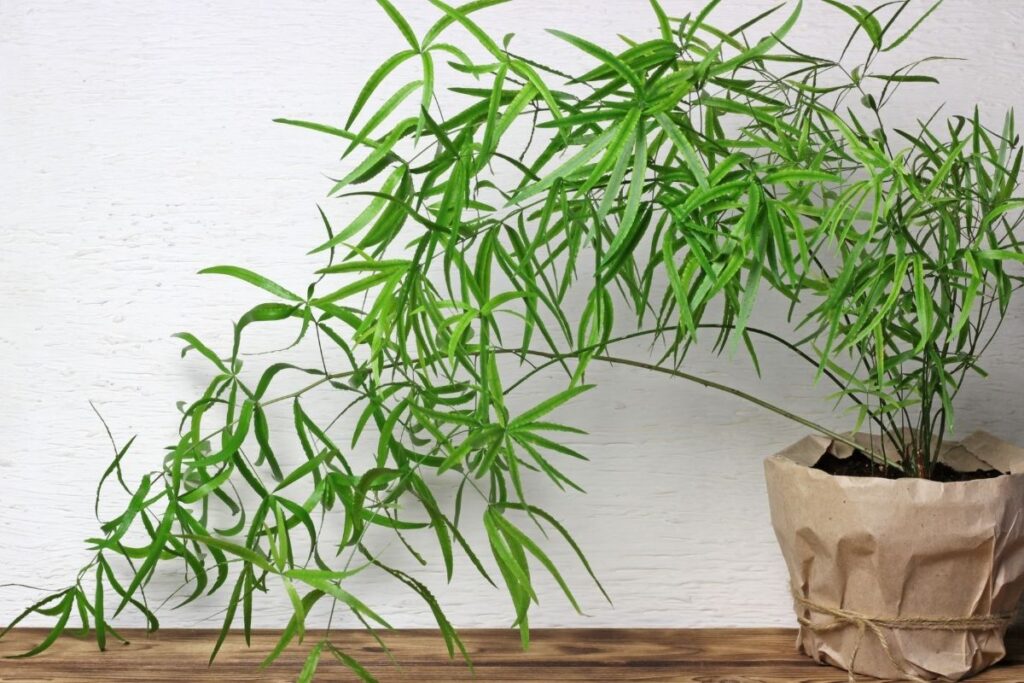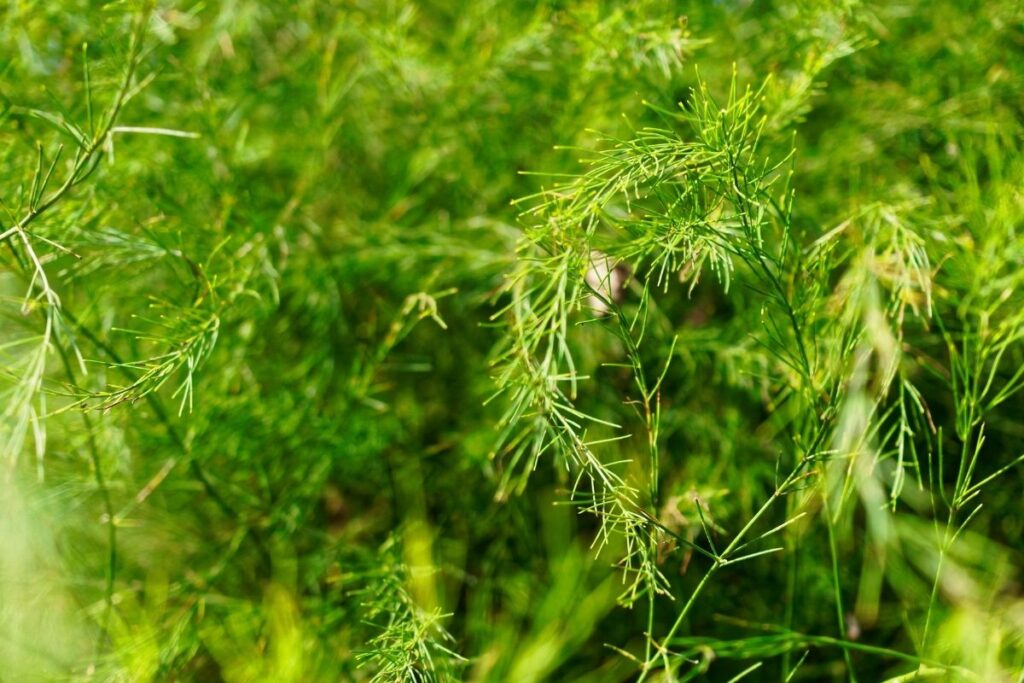Today we are going to showcase our favorite asparagus flowers for both growing for display and harvesting for nutrition. This classic vegetable is grown in a collection of wonderful flowers and they come in both ornamental and growing options.
It is known as a long-lived perennial vegetable which means that it can live for more than two years, making it an ideal annual option for harvesting. In fact, some types of asparagus can live to be up to 30 years!

What you also might not be aware of is that there are both male and female versions. Most gardens will typically favor the male version, the females produce seeds and small seedlings that compete with established flowers and plants, which is important to consider for those looking for an asparagus haul.
We’ve also added in our favorite ornamental asparagus flowers that you can grow at home, so there’s going to be something for everybody!
1. Asparagus Retrofractus (Asparagus Fern)

This plant is native to the southern areas of Africa, specifically Namibia, Botswana, and South Africa, and is more commonly known as Ming Fern. It’s a little plant that feels nice to run your hands through and has a beautiful natural green color.
It tends to bush out and will need a bit of space on either side to allow the plant to express itself, so make sure to let this one breathe.
You won’t need to water this often, especially if you place the flower in a moderate light setting. and you could get away with watering this once per week. You would do well to go with soil that is well-draining and doesn’t require a lot of maintenance as it doesn’t easily shed its stalks.
Overall this is one of our favorite species of asparagus and would fit well for all levels of gardener or horticulturist.
RELATED: Decorate Your Home and Garden With Amazing 23 Types of Fern Species
2. Asparagus Setaceus

The Asparagus Setaceus is a beautiful ornamental plant that is native to the south and eastern parts of Africa and has been introduced to other parts of the world such as Europe, New Zealand, and Australia. It has a natural light feel to it and will make any room that much brighter with its light green color.
As the Setaceus is known to thrive in tropical climates, it doesn’t require a lot of maintenance, however, it would be best suited in a place with high humidity making this an ideal choice for bathroom or greenhouses.
The lighter the room the more water it will require and if you use a terra cotta, be sure to water more frequently as the soil dries quicker.
3. Jersey Knight Asparagus

This is an all-male variety of asparagus that offers tasty asparagus full of vitamins A, B6, and C, as well as being high in fiber and potassium. As they are heavy feeders they are known to stay in the same soil for many years and require patience to grow and maintain.
Your best bet is to space them 18 inches apart in a neat row.
When choosing a location for your Jersey knight, make sure you commit to this area, in a bed that is raised six inches, as this is a perennial vegetable. And if you’re ready to harvest, make sure to go below the ground to encourage more root growth for further harvesting in the future.
4. Asparagus Acutifolius

This is an evergreen perennial commonly known as wild asparagus. With this type of flower, you’ll immediately notice the bell-shaped clusters, that are green-white to yellow, with leaves that are needle-like stems.
You’ll mainly find this growing in the Mediterranean Basin near woods and uncultivated places.
They typically grow to be around 30-70 centimeters long and you will find most of the flowering occurs in late Summer to early Autumn. They are typically ripened to their full extent by winter and taste great when seasoned with oil and lemon juice.
5. Asparagus Cochinensis

Sometimes referred to as Chinese Asparagus, this is distributed throughout eastern Asia across countries like Japan and the Philippines. This perennial flower can grow to be up to 1 meter and is typically found near shorelines and roadsides and is now widely available in the western world.
We love the wild natural green color and how much this blossoms when grown in well-drained soil under decent light. The roots and stems can also be used in traditional Chinese and Korean medicine making this an excellent remedy for common ailments.
If you need a bit of sparkle in your interior location, go with the Cochinensis
6. Asparagus Densiflorus Nana

Asparagus Densiflorus Nana is an eye-catching fern also commonly known as Dwarf asparagus. It features light emerald green leaves that are famously known for being feathery and light. This can grow to be up to 40 centimeters long and is one of our favorite ornamentals due to its unique look.
We love this particular Asparagus variety for pots and baskets, and this would be an ideal gift for anyone that wants to brighten up a room. For the best place, we recommend you locate the Densiflorus Nana on a windowsill or in a bright location. Just make sure to not over-water this one.
7. Asparagus Falcatus

If you look in the Asparagus family. You’ll see that many of the varieties originate from the southern parts of Africa. In South Africa and Mozambique, you’ll find the Falcatus in abundance, especially around the Eastern Cape and Kwazulu Natal. Fun fact: it’s a security hedge due to its thorns!
What’s great about the Falcatus is that it has long shoots that can often reach up to 7 meters high. It features long stickles like shiny leaves, and the older stems will have a light grey color to them.
It produces white blossoms and is typically a bright red berries follows. Making this a hot attraction for local wildlife such as birds and insects.
8. Asparagus Densiflorus (Foxtail Fern)

We love this unique-looking species of asparagus that you’ll find cultivated throughout southern Africa such as Mozambique and South Africa. They have these amazing arching plumes along with bundles that are needle-like leaves. It almost reminds you of a certain golden-brown animal’s tail!
As Foxtail fern cannot grow in cold temperatures. They are best to grow under glass and are unique asparagus for greenhouses or as a houseplant. The clusters of small white flowers are accompanied by red berries with a soft light green color that reminds us of spring. A great choice for budding horticulturalists.
9. Asparagus Scandens

Scandens, or as the Climbing asparagus, is another South Africa native that can grow up to 2 meters in length. It prefers shady areas and loves an air with moisture. But still can handle long periods with water so bear this in mind when maintaining.
We find this to be an elegant-looking species, and adore the thin-like needles that this produces. As well as the tiny white followers so synonymous with asparagus. Similar to some of the other ornamental plants, this springs orange-red berries.
Just be wary as looks can be deceiving: this is registered as an invasive species. And is even on the list of National Pest Plant Accord in New Zealand meaning that one cannot sell it.
10. Asparagus Schoberioides

Heading back to southeast Asia, you can find the Schoberiodes around Japan. And can be common for food and medicinal purposes. It’s easy to grow from seeds and can grow up to 1 meter in height.
We love the frilly foliage and red berries that insects and birds alike will enjoy. It also turns a lovely autumnal yellow during the fall. Average well-drained soil works best, with plenty of sunlight.
11. Asparagus Asparagoides

Here’s a personal favorite and one of the most delightful scrambling scrubs. Asparagoides is famous for its twisting, wiry, and spineless stems that can grow up to 3 meters in length. Commonly found in forests, woodlands, and along river banks, many provinces such as Namibia, Lesotho, and Swaziland.
It has a shiny green leaf-life color and has flattened stems. As opposed to true leaves you see on other asparagus types. White flowers usually appear during the months of July to September.
RELATED: Common Lawn Weeds With White Flowers (And How To Get Rid Of Them?)
12. Asparagus Capensis

If you speak Afrikaans, you’ll know the Capensis by the name ‘cat-thorn’. Found in stony slopers throughout the Cape of South Africa to Namibia. But is also common in western rainfall areas inland and along the coastline.
You can often see that this is star-shaped, and feature white-colored flowers. Each branch will have a collection of whorls that spread around it, each packed tightly with tiny leaves. Our favorite thorny asparagus.
Final Thoughts
There is more to asparagus than a tasty and nutritious vegetable. Whether you find enjoyment in a male or female version that can grow delicious food or an ornament that looks beautiful both on window sills or away from the window in shade, there’s a species for everyone and every occasion.
As long as you take the time to maintain and care for your flowers, asparagus is an easy option to grow and would be the perfect choice for avid horticulturalists that want a seasonal treat throughout the Spring and summer months.
And the good news is that many of our selections are perennial, which is ideal for annual growth and harvesting.







